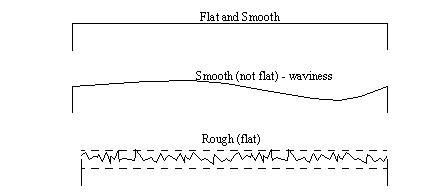1. SURFACES• No surface is perfectly smooth, but the better the surface quality, the longer a product generally lasts, and the better is performs. • Surface texture can be difficult to analyze quantitatively. Two surfaces may be entirely different, yet still provide the same CLA (Ra) value. • Recent developments in production technique, and metrology equipment have made it possible to specify and measure surface quality. • There are standards, such as the CSA B95 1962. • Surface Quality can be important when dealing with, - lubrication - small indentations can hold lubricant - resistant to wear - smoother surfaces wear less - tool life - rough surfaces will correlate to shorter tool life - corrosion - smoother surfaces easier to clean, less surface area to erode - noise reduction - smooth surfaces make less noise when rubbing, for example meshing gears. - fit - pressure seals could leak through pits • Surface geometry can be quantified a few different ways. 
• Real surfaces are rarely so flat, or smooth, but most commonly a combination of the two. 
• Some other terms of interest in surface measurement, - Surface texture - all of the details that make up a surface, including roughness, waviness, scratches, etc. - Lay - the direction of the roughness on a newly manufactured surface. The roughest profile will be perpendicular to the lay. - Flaws - small scratches, cracks, inclusions, etc. - Cutoff - a value selected to be less than the waviness, but greater than the roughness length. This is controlled using electrical or digital filters. Typical values might be; 0.010”, 0.030”, 0.100” 1.1 MEASURES OF ROUGHNESS1.2 METHODS OF MEASURING SURFACE ROUGHNESS1.3 OTHER SYSTEMS1.4 PRACTICE PROBLEMS1.5 PRACTICE PROBLEMS |